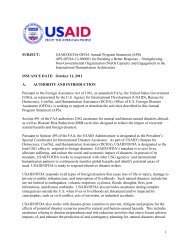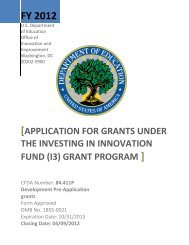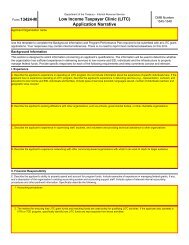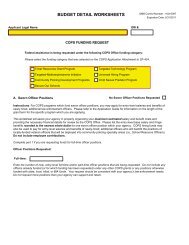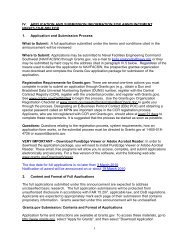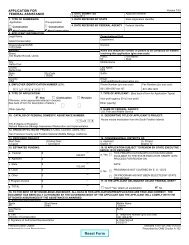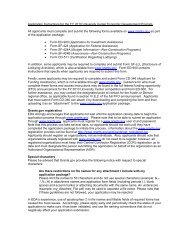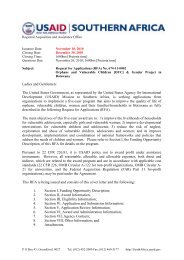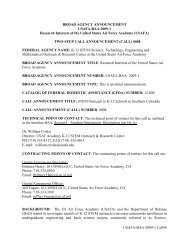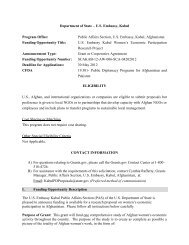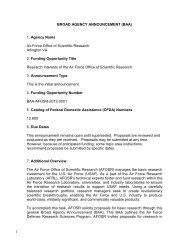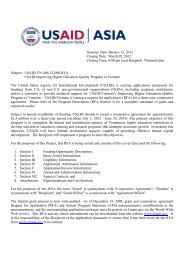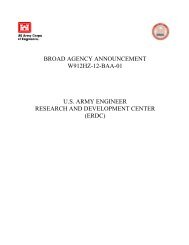USAID/DCHA/OFDA Annual Program Statement (APS) - Grants.gov
USAID/DCHA/OFDA Annual Program Statement (APS) - Grants.gov
USAID/DCHA/OFDA Annual Program Statement (APS) - Grants.gov
Create successful ePaper yourself
Turn your PDF publications into a flip-book with our unique Google optimized e-Paper software.
SUBJECT:<strong>USAID</strong>/<strong>DCHA</strong>/<strong>OFDA</strong> <strong>Annual</strong> <strong>Program</strong> <strong>Statement</strong> (<strong>APS</strong>) No. <strong>APS</strong>-<strong>OFDA</strong>-12-000004 <strong>OFDA</strong>-FY-12-000004-<strong>APS</strong> for Operationalizing a NeighborhoodApproach to Reduce Urban Disaster Risk in Latin America and theCaribbeanISSUANCE DATE: February 27, 2012A. AUTHORITY AND INTRODUCTIONPursuant to the Foreign Assistance Act of 1961, as amended (FAA), the United States Government(USG), as represented by the U.S. Agency for International Development (<strong>USAID</strong>), Bureau forDemocracy, Conflict, and Humanitarian Assistance (<strong>DCHA</strong>), Office of U.S. Foreign DisasterAssistance (<strong>OFDA</strong>), is seeking to support or stimulate the activities described in this <strong>Annual</strong><strong>Program</strong> <strong>Statement</strong> (<strong>APS</strong>).Section 491 of the FAA authorizes USG assistance for natural and human-caused disasters abroad,as well as disaster risk reduction (DRR) activities designed to reduce the impact of recurrent naturalhazards and foreign disasters.Pursuant to Section 493 of the FAA, the <strong>USAID</strong> Administrator has been appointed as thePresident’s Special Coordinator for International Disaster Assistance, with responsibility topromote maximum effectiveness and coordination by USG agencies and between the U.S. andother donors in responses to foreign disasters. <strong>USAID</strong>/<strong>OFDA</strong> provides technical support to thePresident’s Special Coordinator for International Disaster Assistance and coordinates the U.S.Government response to disasters in foreign countries. <strong>USAID</strong>/<strong>OFDA</strong> is the primary operatingunit within <strong>USAID</strong> for the provision of international disaster assistance, except for (1)emergency food aid, where <strong>USAID</strong>’s Office of Food for Peace (<strong>DCHA</strong>/FFP) is considered theprimary operating unit, and (2) cases where a determination is made that a country is in transitionto democracy and <strong>USAID</strong>’s Office of Transition Initiatives (<strong>DCHA</strong>/OTI) is designated as theprimary operating unit. To this end, the <strong>USAID</strong>/<strong>OFDA</strong> Director is responsible for planning,developing, implementing, monitoring, and evaluating assistance for international disaster reliefand DRR activities.<strong>USAID</strong>/<strong>OFDA</strong> responds to all types of foreign natural disasters, including earthquakes, volcaniceruptions, cyclones, floods, droughts, wild fires, pest infestations, and disease outbreaks.<strong>USAID</strong>/<strong>OFDA</strong> also provides assistance when lives or livelihoods are threatened by catastrophes,such as civil conflict, acts of terrorism, or technological disasters. Disasters cause loss of life orinjury, damage to private or public infrastructure, and interruption of livelihoods. Foreign disasterscomprise both acts of nature and human-caused events that threaten lives and disrupt economic and1
social activities. <strong>USAID</strong> defines a foreign disaster as one which occurs outside the United States,its territories, or possessions, and may be:Sudden-onset disasters, such as a flood, tsunami, hurricane, wildfires, earthquake,volcanic eruption, and secondary disasters induced by these extremes, such as landslides,or civil disturbances;A human-caused act, such as civil strife, often causing internal displacement of largenumbers of people;A complex emergency that usually includes a combination of humanitarian, political, andmilitary dimensions; orA slow-onset disaster, such as drought, food insecurity, or epidemic.<strong>USAID</strong>/<strong>OFDA</strong> not only responds to disasters but also works with disaster-prone countries toprevent, mitigate, and prepare for the effects of recurrent natural disasters. This includesassistance relating to disaster preparedness, and to risk reduction activities, to lessen adverseimpacts of, and to enhance the prediction of and contingency planning for natural disastersabroad. Disaster planning and preparedness may include identifying vulnerability to recurrentnatural hazards in a country or region, building capacity for effective and timely responsestrategies, and conducting advance planning for relief, rehabilitation, and reconstruction.Disaster risk reduction measures implement activities to reduce adverse impact of naturaldisasters on human life, livelihoods, and property through activities to increase resiliency tonatural hazards. Recognizing the benefits in lives and resources saved, <strong>USAID</strong>/<strong>OFDA</strong> providesDRR to reduce risks to vulnerable people and property posed by natural and human-causedhazards. DRR activities take many forms, including, but not limited to:Building capacity of national and local disaster management entities and communities ontimely and effective response and preparedness;Provision of technical assistance in national disaster planning for institutions, officials,and other individuals in disaster-prone countries to improve disaster management;Implementation of community-based disaster risk reduction, such as community-focusedtsunami preparedness; andStrengthening hazard early warning system capacities.The purpose of this <strong>APS</strong> is to disseminate information to enable prospective applicants to decidewhether to seek <strong>USAID</strong>/<strong>OFDA</strong> funding in support of the subject Operationalizing a NeighborhoodApproach to Reduce Urban Disaster Risk in Latin America and the Caribbean program and, if so,to assist them in developing and submitting applications. <strong>USAID</strong>/<strong>OFDA</strong> assumes no liability forreimbursing potential applicants for any costs they incur in the preparation and submission ofapplications.This <strong>APS</strong>: (1) provides contextually relevant background information; (2) describes the programaim, results, and types of activities for which applications will be considered; (3) describes thelevel of funding available and the process and requirements for submitting applications; (4)explains the criteria for evaluating and selecting applications; and (5) refers prospectiveapplicants to related documentation available on the Internet.2
<strong>USAID</strong>/<strong>OFDA</strong>’s Guidelines for Unsolicited Proposals and Reporting, which is available athttp://www.usaid.<strong>gov</strong>/our_work/humanitarian_assistance/disaster_assistance/resources/pdf/updated_guidelines_unsolicited_proposals_reporting.pdf, stipulates that they do not apply to <strong>Annual</strong><strong>Program</strong> <strong>Statement</strong>s. However, many parts of those Guidelines are equally applicable regardlessof whether <strong>USAID</strong>/<strong>OFDA</strong> solicits applications (such as through this <strong>APS</strong>) or an organizationsubmits an unsolicited application. Thus, for the sake of brevity and in order to preventunnecessary redundancies, parts of this <strong>APS</strong> may refer potential applicants to those Guidelinesand/or may specify that it is an explicit exception to those Guidelines. In the event of anyinconsistencies between this <strong>APS</strong> and those Guidelines, this <strong>APS</strong> shall prevail.As of November 1, 2005, the preferred method of distribution of <strong>USAID</strong> <strong>APS</strong>’ and submission andreceipt of applications is electronically via http://www.grants.<strong>gov</strong> (“<strong>Grants</strong>.<strong>gov</strong>”), which provides asingle source for USG-wide competitive grant opportunities. This <strong>APS</strong> and any future amendmentsor additions can be downloaded from that website. In order to use this method, an applicant mustfirst register on-line with <strong>Grants</strong>.<strong>gov</strong>. If the applicant has difficulty registering or accessing the<strong>APS</strong> or related documents, the applicant should contact the <strong>Grants</strong>.<strong>gov</strong> Helpdesk at 1-800-518-4726or via e-mail at support@grants.<strong>gov</strong> for technical assistance. It is the responsibility of the recipientof the <strong>APS</strong> and any related documentation to ensure that it has been received from <strong>Grants</strong>.<strong>gov</strong> in itsentirety and <strong>USAID</strong> bears no responsibility for data errors resulting from transmission orconversion processes. It is important that interested organizations sign-up for e-mail updates with<strong>Grants</strong>.Gov so that as changes are posted to this and other USG (including <strong>USAID</strong>) solicitations,alerts will be received.B. SPECIFIC PROGRAMMATIC GUIDANCE1. BackgroundThe <strong>USAID</strong>/<strong>OFDA</strong> Regional Office for Latin America and the Caribbean (LAC), headquarteredin San Jose, Costa Rica, was established in 1983. During the early years, <strong>USAID</strong>/<strong>OFDA</strong>’s workfocused principally on responding to emergencies in the region. However, by the late 1980s,<strong>USAID</strong>/<strong>OFDA</strong> began to complement response activities with a program of training for firstresponders and emergency managers. Through the years, this training program has evolved fromfocusing primarily on <strong>USAID</strong>/<strong>OFDA</strong>-funded training to a multi-layered program providingspecialized technical assistance to participating agencies in host countries, which for the mostpart assume the training costs themselves. Today, <strong>gov</strong>ernments and organizations in 30 countriesparticipate in the <strong>USAID</strong>/<strong>OFDA</strong> Regional Disaster Assistance <strong>Program</strong> (RDAP), which focuseson training and technical assistance for both response and disaster risk reduction (DRR)activities.For more than a decade, <strong>USAID</strong>/<strong>OFDA</strong> has supported a variety of DRR initiatives in the regionto raise awareness of and build the capacity of local <strong>gov</strong>ernments and organizations to preparefor and respond to natural disasters frequently encountered in Latin America and the Caribbean.These efforts have included interventions at both policy and operational levels and promotedpreparedness and mitigation themes.3
In 2009, <strong>USAID</strong>/<strong>OFDA</strong>’s LAC regional office in San José developed a five-year disaster riskreduction (DRR) plan to further enhance and focus its approach for promoting self-sufficiency indisaster preparedness, management and mitigation at local and national levels. The three keycomponents of the plan are:Safeguarding livelihood assetsPreventing the loss of shelterBuilding capacity for disaster risk management and risk reductionPriority is placed on areas with at-risk populations, as well as areas recently affected by disasters,historically vulnerable areas, areas either undergoing rapid urbanization and unplanned growth orslated for expansion, and areas undergoing post-disaster transition.In 2011, the <strong>USAID</strong>/<strong>OFDA</strong> DRR strategy for LAC 1 was updated for 2012-2014 to prioritize urbandisaster risk reduction as an area of interest and align the strategy with the Hyogo Framework ofAction.Disaster Risk Management in the Urban EnvironmentUrban areas present a number of unique challenges and opportunities for responding to andbuilding resiliency against the impacts of disasters including 2 :Cities in the developing world are facing increased risk of disasters and the potential ofeconomic and human losses from natural hazards is being exacerbated by the rate ofunplanned urban expansion and influenced by the quality of urban management.Climate change brings additional challenges with a growing number and variety of impactson cities, their critical ecosystems and citizens’ livelihoods.New residents and the urban poor living in peri-urban areas and informal settlements areparticularly vulnerable due to their tendency of residing in high risk areas and faultyshelters, having limited access to basic and emergency services, and a general lack ofeconomic resilience.The option of doing nothing can be more costly than proactively identifying and managingrisks. If no steps are taken to identify and manage disaster risks and climate change,resulting losses will have severe implications on the safety, quality of life and economicperformance of cities.Better urban management and <strong>gov</strong>ernance is at the heart of reducing disaster risk andclimate change risks and making cities safer.Cities can plan and respond better if the location and nature of risk is known, and also if therisk assessment and management processes are mainstreamed in urban development andmanagement programs.1http://www.usaid.<strong>gov</strong>/our_work/humanitarian_assistance/disaster_assistance/sectors/files/fy2012/lac_drr_plan.pdf2 World Bank (2011). Urban Risk Assessments: An Approach for Understanding Disasters and Climate Risk inCities.4
The January 2010 earthquake in Haiti awakened awareness of these challenges and the integralneed to address the numerous, complex, and pervasive issues that arise during a response to adisaster in a large urban area. However, the risks and conditions in Haiti that resulted incatastrophic loss and damages are not unique in the region – the continued, rapid growth of citiesthroughout LAC exposes ever-increasing numbers of people to the numerous natural hazardsprevalent in the region while the impacts of climate change further present challenges for buildingdisaster resilience in urban areas:In 2001, <strong>USAID</strong>/<strong>OFDA</strong> and the U.S. Geologic Survey (USGS) collaborated on aninformal ranking of the developing country cities at highest earthquake risk worldwide.Based on an evaluation of seismic hazard, quality of building stock, size of population,and projected response capacity, eight cities in the LAC region were included among thetop 20 cities with the highest risk.Offshore seismic activity contributes to an elevated tsunami hazard in LAC. Although notall tsunamis are basin-wide or destructive, on average, the Pacific region is affected by atsunami every two years. Recent tsunamis affecting LAC in the Eastern Pacific havehighlighted coastal vulnerabilities and gaps in preparedness. Cities and coastal towns suchas Masachapa, Nicaragua; Puntarenas, Costa Rica; Tumaco, Colombia; and Concepción,Chile are all highly vulnerable, and most have suffered loss of life or infrastructure damagefrom tsunami events over the last two decades. The Caribbean is also exposed to localizedand distant tsunami-producing sources.The LAC region includes approximately 350 potentially active volcanoes, and many ofthem are close enough to produce eruptions that can impact urban areas. The two mostdeadly eruptions in the 20th century occurred in the LAC region: the Mt, Pelée volcano inMartinique resulted in approximately 29,000 deaths in 1902, and the Nevado Del Ruizvolcano in Colombia resulted in approximately 23,000 deaths in 1985.The combination of hydro-meteorological phenomena, including hurricanes and othertropical phenomena, and topographical characteristics places large numbers of marginalneighborhoods and their residents at high risk on a repeated, seasonal basis. Climate changehas a multiplier effect on these hydro-meteorological hazards, increasing the probability ofextreme weather events such as heat waves, torrential rains and droughts. In the Andes, therecession of glaciers – the major water source for Pacific Coast cities – will likely causedisruption and/or shortages in the water supply as well as sudden-onset flooding, glacierlake outburst floods, and other natural hazards.In 2010, approximately 80 percent of the population in the LAC region was estimated to reside incities. By 2050, the urban population in LAC is predicted to grow by nearly 10 percent 3 . Yet,throughout the LAC region, the growth of cities has often been haphazard; as a result of highdensity settlement, large numbers of residents in urban areas are exposed to elevated levels of riskacross a broad range of factors, including underlying socio-cultural, economic, and environmentalconditions. As evidenced by the impacts of the January 2010 earthquake in Haiti, withoutappropriate planning, preparedness and mitigation measures to specifically address the needs ofgrowing urban populations, the impacts of future disasters can have devastating consequences.3 United Nations, Department of Economic and Social Affairs, Populations Division (2009). World UrbanizationProspects: The 2009 Revision.5
At the same time, however, the urban sector offers certain advantages with regard to DRR,including availability of professionals in all disciplines; broad diversity of private sector activities;access to media; and potential to influence key decision-makers, among others.Addressing urban risk by focusing on neighborhoods<strong>USAID</strong>/<strong>OFDA</strong> urban DRR efforts are aimed at reducing risk in informal and marginalizedneighborhoods by supporting sustainable participatory planning methodologies and theimplementation of risk mitigation measures. These measures include:Improving unsafe living environmentsClarifying ambiguous land tenure and rights to build/occupy shelterImproving access to neighborhood health, markets, water, and sanitation servicesAddressing limitations of space and high population densityAddressing poverty and economic vulnerabilityReducing vulnerability to floods, landslides, high winds, and seismic activity.One of <strong>USAID</strong>/<strong>OFDA</strong>’s main contributions towards the improvement of the conditions in informalsettlements is the “neighborhood approach.” The “neighborhood approach,” which has been fieldtested in Haiti and other disaster-affected parts of the world, is an integrated, multi-sectoralanalytical framework to address the multi-faceted challenges posed by the urban environment. Byfocusing on neighborhoods – geographic areas of cities typically defined by social, economic, andphysical features, which often serve as the basis for administrative/political recognition withinlarger jurisdictions and which provide their residents with an identity in the urban arena – theframework enables an understanding of available local resources, emergent opportunities, andpotential constraints regarding the sheltering of people, the recovery of affected economies andlivelihoods, and the reduction of risks associated with vulnerability to natural hazards.The neighborhood approach encompasses a number of elements that share four maincharacteristics:Compliance with local laws and regulations as well as internationally recognized guidelinessuch as the Sphere Project;Fosters the reduction of the economic and social impacts of present and future disasters;Reflects the needs of the main stakeholders, especially those deemed the most vulnerable;Relies on the use of Geographic Information Systems (GIS) to collect, analyze, store, anddisseminate information.The neighborhood approach permits a move away from conventional “four walls and a roof” effortsfocused on households, and towards a more synergistic and complementary focus on communitiesin defined spatial contexts – neighborhoods. It provides a base for coordinated efforts towardssustainable engagement with communities by defining the framework within which housing,infrastructure, transport, integrated environmental and natural resource management, and futuregrowth occur.6
While conceived to facilitate post-disaster recovery the neighborhood approach is clearly relevantfor urban DRR programming as well. <strong>USAID</strong>/<strong>OFDA</strong> believes that by working closely withresidents through a participatory, consultative neighborhood planning process, informed decisionmakingon improved land utilization – configuring/reconfiguring land to best accommodate shelterand related services, livelihoods, social connections, and the health and security of populations –will save lives, alleviate suffering, and reduce the social and economic impact of disasters.<strong>USAID</strong>/<strong>OFDA</strong> plans to award up to $6 million in FY 2012 for the implementation of activities inthe LAC region that operationalize the neighborhood approach as a means of reducing disaster riskin urban settings. Final funding levels will depend on quality of applications, availability offunding and competing priorities.2. <strong>Program</strong> Scope and Objective(s) of this <strong>APS</strong><strong>USAID</strong>/<strong>OFDA</strong>’s mandate is to save lives, alleviate human suffering, and reduce the economicimpact of disasters worldwide. The objective of this <strong>APS</strong> is to support innovative and/or provenways to reduce the risk of disasters to shelter, livelihoods and water and sanitation services inhazard-prone, vulnerable urban settlements, particularly marginalized and/or informalneighborhoods and populations, through applying a neighborhood approach.To successfully achieve the objective of this <strong>APS</strong>, applications must incorporate the following fourphases of the neighborhood approach in the technical description of the project:1. Participatory Risk Assessments and Planning (if needed)2. Formulation and Adoption of DRR Plans3. Selection and Implementation of Activities4. Systematization and Dissemination of Project ResultsParticipatory Risk Assessment and PlanningNote: Applications demonstrating expertise and strong contextual understanding of proposedlocations based on prior comprehensive participatory urban risk assessments will receivepreference. Applications for assessment projects as standalone activities will not be considered forfunding.While applications should reflect a strong understanding of risks and resources/opportunities in theproposed targeted urban areas/neighborhoods, including identification of key vulnerabilities andexposures, <strong>USAID</strong>/<strong>OFDA</strong> understands that applicants may not have complete information on allthe risk scenarios in targeted neighborhoods. Applications should detail the project planningprocess, including participatory risk assessments that will be conducted at the onset of the project tovalidate needs and ensure that implementation plans comprehensively and appropriately addresscommunity needs. Applications should clearly describe methodology for conducting a detailedparticipatory risk assessment as part of the planning process prior to final implementation ofactivities. Key components of the planning phase to be addressed in the application include:7
Identification of existing hazard and vulnerability/exposure maps and studies. Primarydata collection should complement existing sources only when required.Mapping of and coordination with relevant <strong>gov</strong>ernmental and non-<strong>gov</strong>ernmental actorsand other local resources, including community-based organizations and men’s andwomen’s groups, as appropriate.Collection of information on land parcels (geo-referenced); land utilization (constructiontype and function), tenancy status (private vs. public, owner-occupied vs. rented), andsocio-economic data, sex- and age-disaggregated when possible.Formulation and Adoption of Implementation PlansSuccessful applicants will be required to submit a detailed implementation plan to <strong>USAID</strong>/<strong>OFDA</strong>for final approval following the completion of the planning phase. The interventions described inthe plan will be reviewed by an inter-disciplinary team from <strong>USAID</strong> and may also includerepresentatives of key outside actors.Implementation plans should comprehensively address needs identified during the participatory riskassessments including:Facilitation of information-sharing, including support or development of GeographicInformation Systems (GIS) and other data collection and management tools andprocesses, between community stakeholders and relevant municipal authorities.Engagement of local <strong>gov</strong>ernment at strategic and operational levels to promote projectsustainability.Promotion of sustainable land tenure policies and integration of basic municipal services,including water, sewage, electricity, and sewage waste collection, with local<strong>gov</strong>ernments.Development of local <strong>gov</strong>ernment capacity for project sustainability.Applications should clearly describe the process for developing a detailed implementation planbased on findings during the planning phase, including coordination with relevant stakeholders toensure community engagement and long-term sustainability of project activities.Selection and Implementation of ActivitiesSelection and implementation of activities must fall within the three priority sector under this <strong>APS</strong>:Shelter and Settlements (S&S), Economic Recovery and Market Systems (ERMS), and/or Water,Sanitation, and Hygiene (WASH). Final project activities will be contingent on the planning phaseand development of an approved implementation plan; however, applications should demonstrate astrong contextual understanding of targeted neighborhoods, including risks and vulnerabilities, aswell as an appropriate methodology and available resources to implement proposed projectactivities.Systematization and Dissemination of Project Results8
Neighborhood reconfiguration to:o Improve accessibility to basic services, markets and evacuation routes.o Open up space for future infrastructure improvements and population growth(densification).o Voluntarily relocate of especially vulnerable households to safer locations.Construction, repair and upgrading of critical infrastructure such as drainage canals, etc.Improvements to housing resilience through retrofitting, repairs and upgrading.Economic Recovery and Market SystemsAll ERMS sector activities must fall within the following sub-sectors:Economic Asset DevelopmentEconomic Asset RestorationMarket Infrastructure RehabilitationMicrocreditMicrofinance Institutions (MFIs)Within the ERMS sector, activities must be linked to the <strong>APS</strong> program objective of reducing therisk of disasters to shelter, livelihoods and water and sanitation services in hazard prone andvulnerable urban areas through applying a neighborhood approach. Proposed activities under theERMS sector could include, but are not limited to:Baseline market-system assessments of critical goods and services in neighborhoods andcities as part of the first phase of community-based assessment. 5 This might be, forexample, an assessment using the Emergency Market Mapping & Analysis (EMMA)methodology.Interventions to improve the resilience of critical market systems to likely future disasters,including:o Capacity-building or awareness-raising among small business owners.o Facilitating disaster contingency planning throughout the market system.o Improving disaster resilience of key market infrastructure (e.g. businesses, storage,transportation) with contributions from relevant market actors.o Protecting livelihood assets, incomes, or access to finance at the household level toavoid negative coping strategies in the event of a disaster.Identifying and supporting micro/small enterprise or employment opportunities directlylinked to disaster risk reduction in shelter or water, sanitation and hygiene including:o Waste management, composting, WASH-related services.o Manufacture or sale of disaster-preparedness items.Please note that the use of cash-for-work for community infrastructure repair or natural resourcemanagement activities will not be considered for funding under this <strong>APS</strong>.5 Critical goods and services are defined as those that play a key role in the survival or livelihoods of vulnerablepeople, either currently or in the event of a disaster.11
Applications including activities under the ERMS sector must demonstrate:A solid understanding of livelihood patterns and relevant market systems in proposed targetproject locations.The likely impacts of potential disasters on market systems and livelihood patterns.How proposed interventions would mitigate negative impacts of potential disasters.A strong focus on sustainability, informed by careful market analysis.Water, Sanitation and HygieneAll WASH sector activities must fall within the following sub-sectors:Environmental HealthHygiene PromotionSanitationWater SupplyWithin the WASH sector, activities must be linked to the <strong>APS</strong> program objective of reducing therisk of disasters to shelter, livelihoods and water and sanitation services in hazard prone andvulnerable urban areas through applying a neighborhood approach. All proposed activities must becoordinated with appropriate national and state level <strong>gov</strong>ernment authorities, utilityowners/managers, and/or <strong>gov</strong>ernment emergency management bodies. Proposed activities underthe WASH sector could include, but are not limited to:Documenting existing waste management practices, including solid waste management,medical waste management, and human excreta management.o Identifying risks and recommending mitigation actions.o Recording baseline information of existing practices and infrastructure to helpguide emergency response activities in case of a disaster.o At a minimum, behavioral data should include human excreta practices, solidwaste management, and feminine hygiene practices.o Recommendations to mitigate risks clearly documented and presented to relevantlocal, state, and national <strong>gov</strong>ernment authoritiesAssessing existing drainage within targeted communities and recommending mitigationactivities.o Define problem areas, problematic practices, scope, and severity of problemso Recommend educational or communication strategies to change risky behaviorso Recommend design and construction of new or improvements to existingdrainage infrastructure to reduce vulnerabilities to flooding.Assessing existing hygiene practices within targeted communities.o Document existing hygiene practices and document current efforts, if any, toprovide hygiene education.o Recommend key behavior messages which are needed within targetedcommunities.12
o Develop education and communication strategy with national, state, and localauthorities to improve hygiene messagingAssisting local and national <strong>gov</strong>ernment to locate and document all existing water sourcesin targeted communities.o Assist with the creation of a database or the improvement of existing databases.o Clearly identify which water sources are utilized by which populations and forwhat purposes.o Identify the most important sources of drinking water and conduct a riskassessment and propose mitigation activities.o Minor mitigation activities will be considered for funding, but large scalemitigation activities cannot be funded through this mechanism and should simplybe documented and <strong>gov</strong>ernment authorities should be notified of the risks.o Identifying and mapping water distribution systems and wastewater collectionsystems.o If target communities are served by utilities (water, sewer, and electrical utilities),conducting sanitary surveys and risk assessments of utilities.Improving waste management, water supply, and sanitation through links to the economicrecovery and market systems (ERMS) sector through micro/small enterprise or sustainableemployment opportunities where possibleNatural and Technological RisksAll Natural and Technological Risks sector activities must fall within the following sub-sectors:Disaster preparedness, Mitigation, and ManagementGeological HazardsHydro-meteorological HazardsApplications that include activities within the Natural and Technological Risks sector must alsoinclude at least one of the above priority sectors (S&S, ERMS, WASH). Applicants must clearlydefine how Natural and Technological Risks activities address and relate to proposed activitiesunder the priority sector(s) in the application. Stand-alone Natural and Technological Risks sectoractivities will not be considered under this <strong>APS</strong>.If the above requirements are met, proposed activities under the Natural and Technological Riskssector may include, but are not limited to:Community-based watershed and natural resource management interventions to reduceimpact of hydro-meteorological hazardsIntegrated land-use planning for risk reduction of recurrent multi- hazards such as floods,earthquakes, volcanic eruptions including but not limited to micro-zoningDevelopment and implementation of regional, local, or community-based hazard reductionpolicies and plans, or incorporating hazard reduction policies and plans into existing plansCommunity-based mitigation and preparedness activities for:o Geological events such as earthquakes, volcanic eruptions, and landslides, and13
understanding and sensitivities, and listening skills. <strong>USAID</strong>/<strong>OFDA</strong> encourages the use ofparticipatory methodologies to gather information on the needs and perspectives of women, men,boys and girls. Women should be consulted in equal proportion to men. Evidence suggest thatthe meaningful participation of women is most likely when they are consulted independently ofmen, and when possible, disaggregated by age, and diversity factors, (such as religion andethnicity) particularly when power differentials exist.Applications must demonstrate consideration of the unintended consequences of the proposedintervention to women, men, boys and girls, and show that the program has reviewed theintervention with a “do no harm” lens.3. <strong>Program</strong> DurationThe program duration may be up to 24 months from the date of award. <strong>USAID</strong>/<strong>OFDA</strong> plans tofund approved activities starting in FY2012 (October 1, 2011-September 30, 2012) but reserves theright to incrementally fund activities over the duration of the program, if necessary, depending onprogram length, performance against approved program indicators and availability of funds.4. Anticipated Funding Availability<strong>USAID</strong>/<strong>OFDA</strong> anticipates that up to approximately US$ 6 million will be available to support theprogram(s) or activity(ies) described herein, although final funding levels will depend on content,quality, number of applications received, needs, availability of funding, and competing priorities.<strong>USAID</strong>/<strong>OFDA</strong> will not consider any applications above a maximum amount of US$ 2 million.5. Anticipated Number of Awards<strong>USAID</strong>/<strong>OFDA</strong> plans to make multiple awards under this <strong>APS</strong>. Nevertheless, <strong>USAID</strong>/<strong>OFDA</strong>reserves the right to make a single award, to fund parts of applications, or not to make anyawards at all. Issuance of this <strong>APS</strong> does not constitute an award commitment on the part of theU.S. Government, nor does it commit the U.S. Government to pay for any costs incurred in thepreparation and submission of any application.6. Type of Award(s)/Substantial Involvement<strong>USAID</strong>/<strong>OFDA</strong> anticipates that cooperative agreements will be awarded as a result of this <strong>APS</strong>.Cooperative agreements are identical to grants except that <strong>USAID</strong>/<strong>OFDA</strong> may be substantiallyinvolved in the following areas:(a) <strong>USAID</strong>/<strong>OFDA</strong> approval of the recipient’s implementation plans (limited tonot more frequently than annually);(b) <strong>USAID</strong>/<strong>OFDA</strong> approval of specified key personnel (limited to 5 positions or5% of the recipient’s total team size, whichever is greater);15
(c) <strong>USAID</strong>/<strong>OFDA</strong> and recipient collaboration or joint participation whichincludes one or more of the following:Collaborative involvement of selection of advisory committeemembers (<strong>USAID</strong>/<strong>OFDA</strong> may also choose to become a member), ifapplicable;<strong>USAID</strong>/<strong>OFDA</strong> concurrence on the selection of sub-award recipientsand/or the substantive technical/programmatic provisions of subawards;<strong>USAID</strong>/<strong>OFDA</strong> approval of a program monitoring and evaluation[M&E] plan (to the extent that such information is not included in theapplication);<strong>USAID</strong>/<strong>OFDA</strong> monitoring to permit direction or redirection becauseof interrelationships with other projects; and(a) <strong>USAID</strong>/<strong>OFDA</strong> authority to immediately halt a construction activity, ifapplicable.7. Cost-Sharing (Matching)(a)NGOsNGOs are not required to include counterpart funding. However, applications that includeadditional in-kind and/or cash contributions from non-USG sources will be more competitive, sincecost-sharing demonstrates a strong commitment to the planned activities and will be rewardedunder the “cost-effectiveness” evaluation criterion set forth in Section F below. Cost-sharing willbe subject to 22 CFR 226.23 and the standard provision entitled “Cost Sharing (Matching)” (U.S.NGOs) or the standard provision entitled “Cost-Sharing (Matching)” for non-U.S. NGOs (seeSection G.2 below).(b)PIOsPIOs are required to provide at least 10% of the total program cost of in-kind and/or cashcontributions from non-USG sources. Any cost-sharing above this amount will be rewarded underthe “cost-effectiveness” evaluation criterion (See Section F below).8. <strong>Program</strong> Income(a)NGOsIf the successful applicant(s) is/are a non-profit organization, any program income generated underthe award(s) will be added to <strong>USAID</strong>/<strong>OFDA</strong> funding (and any cost-sharing that may be provided)and used for program purposes. However, pursuant to 22 CFR 226.82, if the successful applicant is16
a for-profit organization, any program income generated under the award(s) will be deducted fromthe total program cost to determine the amount of <strong>USAID</strong>/<strong>OFDA</strong> funding. <strong>Program</strong> income will besubject to 22 CFR 226.24 (U.S. NGOs) or the standard provision entitled “<strong>Program</strong> Income” fornon-U.S. NGOs (see Section G.2 below).(b)PIOsAny program income generated under the award(s) will be added to <strong>USAID</strong>/<strong>OFDA</strong> funding (andany non-<strong>USAID</strong>/<strong>OFDA</strong> funding that may be provided) and used for program purposes.9. Authorized Geographic Code(a)NGOs<strong>USAID</strong>’s rules for the source and componentry of goods (other than “restricted goods,” asdescribed in ADS 312 [http://www.usaid.<strong>gov</strong>/policy/ads/300/312.pdf]), and the nationality ofsuppliers of goods and services (other than delivery services, as described in ADS 314[http://www.usaid.<strong>gov</strong>/policy/ads/300/314.pdf]) , which are financed by <strong>USAID</strong> and procured bythe recipient under the award(s) resulting from this <strong>APS</strong>, are set forth in 22 CFR 228(http://www.access.gpo.<strong>gov</strong>/nara/cfr/waisidx_08/22cfr228_08.html). These rules do not apply toprocurement by the recipient with cost-sharing or program income funds. Except as authorizedunder <strong>USAID</strong>’s “Local Procurement” rules (see 22 CFR 228.40), the authorized geographic code(see 22 CFR 228.1) for the award(s) resulting from this <strong>APS</strong> is 935, subject to the recipient’scompliance with the order of preference and file documentation requirements set forth in paragraph(b)(1) of the standard provision entitled “<strong>USAID</strong> Eligibility Rules for Goods and Services” (seeSection G below).(b)PIOsAs indicated in ADS 308, <strong>USAID</strong>’s procurement rules do not apply to awards to PIOs unless<strong>USAID</strong> is the sole contributor to a trust fund established by the PIO (see Section G.3). If <strong>USAID</strong> isthe sole contributor, the same rules, as prescribed in subparagraph (a) above for NGOs, will apply.10. Title to Property(a)NGOsTitle to property financed by <strong>USAID</strong>/<strong>OFDA</strong> under the award(s) will vest in the recipient, and willbe subject to 22 CFR 226.30-37 (U.S. NGOs) or the standard provision entitled “Title To and Useof Property (Recipient Title; Over $50,000) for non-U.S. NGOs (see Section G.2 below).(b)PIOsTitle to property financed by <strong>USAID</strong>/<strong>OFDA</strong> under the award(s) will vest in the recipient withoutfurther obligation to <strong>USAID</strong>/<strong>OFDA</strong>, unless <strong>USAID</strong> is the sole contributor to a trust fundestablished by the PIO (see Section G.3). If <strong>USAID</strong> is the sole contributor, all such property will17
Qualified U.S. and non-U.S. private non-profit organizations may apply for <strong>USAID</strong>/<strong>OFDA</strong> fundingunder this <strong>APS</strong>. Foreign <strong>gov</strong>ernment-owned parastatal organizations from countries that areineligible for assistance under the FAA or related appropriations acts are ineligible.(2) U.S. and Non-U.S. For-Profit OrganizationsQualified U.S. and non-U.S. private for-profit organizations may apply for <strong>USAID</strong>/<strong>OFDA</strong> fundingunder this <strong>APS</strong>. Foreign <strong>gov</strong>ernment-owned parastatal organizations from countries that areineligible for assistance under the FAA or related appropriations acts are ineligible. Potential forprofitapplicants should note that, pursuant to 22 CFR 226.81, the payment of fee/profit to theprime recipient under grants and cooperative agreements is prohibited. However, if a primerecipient has a (sub)-contract with a for-profit organization for the acquisition of goods or services(i.e., if a buyer-seller relationship is created), fee/profit for the (sub)-contractor is authorized.(3) U.S. and Non-U.S. Colleges and UniversitiesQualified U.S. and non-U.S. colleges and universities may apply for <strong>USAID</strong>/<strong>OFDA</strong> funding underthis <strong>APS</strong>. USG and <strong>USAID</strong> regulations generally treat colleges and universities as NGOs, ratherthan <strong>gov</strong>ernmental organizations; hence, both public and private colleges and universities areeligible. Non-U.S. colleges and universities in countries that are ineligible for assistance under theFAA or related appropriations acts are ineligible.(b)Registration as a Private Voluntary Organization (PVO)Pursuant to ADS E251.5.3.(a)6, applicants do not need to be registered with <strong>USAID</strong> as a PVO to beeligible for funding under this <strong>APS</strong>.(c)“Responsibility” of ApplicantIn order for an award to be made, the Agreement Officer must make an affirmative determinationthat the applicant is “responsible,” as discussed in ADS 303.3.9. This means that the applicantmust possesses, or have the ability to obtain, the necessary management and technicalcompetence to conduct the proposed program, and must agree to practice mutually agreed-uponmethods of accountability for funds and other assets provided or funded by <strong>USAID</strong>.The following criteria are used by <strong>USAID</strong> in determining an applicant’s “responsibility:”1) Adequacy of Applicant’s <strong>Program</strong> Description, Budget, and MonitoringSystem.2) Adequacy of the Applicant’s Financial Resources for <strong>Program</strong> Performance.3) Applicant’s Ability to Meet Award Conditions:(A)Compliance of Applicant’s Accounting and Overall Financial and<strong>Program</strong> Management Systems with 22 CFR 226.20-28.19
(B) Compliance of Applicant’s System of Reports and Records with 22CFR 226.50-53.(C)Compliance of Applicant’s Internal Control Systems withApplicable USG Cost Principles.(i) Internal Controls.(ii) Personnel Policy is Reasonable under ApplicableUSG Cost Principles.(iii) Travel Policy is Reasonable under Applicable USGCost Principles and the U.S. Department ofState’s Standardized Regulations (GovernmentCivilians, Foreign Areas)(http://aoprals.state.<strong>gov</strong>/), and Complies with FlyAmerica Requirements.(D) Compliance of Applicant’s Property Management System with 22CFR 226.30-37.(E)(F)(G)Compliance of Applicant’s Sub-Award Administration andMonitoring System with OMB Circular A-133 (U.S. NGOs) or the<strong>USAID</strong> Inspector-General’s Guidelines for Financial AuditsContracted by Foreign Recipients(http://www.usaid.<strong>gov</strong>/policy/ads/500/591maa.pdf) for non-U.S.NGOs.Compliance of Applicant’s Purchasing System/ContractingProcedures with 22 CFR 226.40-49.Applicant’s Absorptive Capacity Given Other Existing andPotential Work Commitments.4) Satisfactory Record of Performance by Applicant.5) Satisfactory Record of Business Integrity by Applicant.6) Applicant is Otherwise Qualified to Receive an Award under Applicable Lawsand Regulations (e.g., Nondiscrimination, Lobbying, Debarment/Suspension,Terrorist Financing, etc.).In the absence of an affirmative “responsibility” determination, an award can ordinarily not bemade. However, in rare cases, an award can be made with “special award conditions” (i.e.,additional non-standard award requirements designed to minimize the risk presented to <strong>USAID</strong>20
of making an award to an NGO for which an affirmative determination of “responsibility” cannotbe made), but only where it appears likely that the applicant can correct the deficiencies in areasonable period.(d)New PartnersPartners new to <strong>USAID</strong> and/or <strong>USAID</strong>/<strong>OFDA</strong> may submit applications. However, resultantawards to these organizations may be significantly delayed if <strong>USAID</strong>/<strong>OFDA</strong> must undertakenecessary pre-award reviews of these organizations to determine their “responsibility” (seesubparagraph [c] above). These organizations should take this into account and plan theirimplementation dates and activities accordingly.(e)Applicants for Additional/Continued <strong>OFDA</strong> Funding of Existing<strong>Program</strong>s (“Cost Extensions”)Current NGO implementing partners must apply for additional/continued <strong>USAID</strong>/<strong>OFDA</strong> funding ofexisting programs under this <strong>APS</strong>.2. Other USG AgenciesUSG departments and agencies may not apply for <strong>USAID</strong>/<strong>OFDA</strong> funding under this <strong>APS</strong>.3. Public International Organizations (PIOs)PIOs are not required to apply for <strong>USAID</strong>/<strong>OFDA</strong> funding under this <strong>APS</strong>.4. Foreign Governmental OrganizationsForeign <strong>gov</strong>ernmental organizations are organizations that function as a <strong>gov</strong>erning body, such asforeign ministries and local <strong>gov</strong>ernments. Foreign <strong>gov</strong>ernmental organizations may not apply for<strong>USAID</strong>/<strong>OFDA</strong> funding under this <strong>APS</strong>. Note: <strong>USAID</strong> policy makes foreign <strong>gov</strong>ernmentalorganizations ineligible as sub-recipients under awards to NGOs unless special approval isprovided. Even if special approval is provided, potential applicants must consider the impact offoreign <strong>gov</strong>ernmental organizations' sovereignty on issues such as audits, cost disallowances,disputes, etc. (see http://www.usaid.<strong>gov</strong>/policy/ads/300/updates/). In addition, <strong>USAID</strong> policies donot permit the payment of "salary supplements" to employees of a host <strong>gov</strong>ernment except inexceptional circumstances and with special approval. Additional guidance on salary supplementsmay be found at: http://www.usaid.<strong>gov</strong>/policy/ads/200/119780.pdf.5. Code of ConductAs a condition for any award resulting from this <strong>APS</strong>, applicants must have adopted a code ofconduct that addresses the protection of beneficiaries of assistance from sexual exploitation andabuse in humanitarian relief operations. Such code of conduct is described in the “Notices”section (page 1) of the <strong>USAID</strong>/<strong>OFDA</strong> Guidelines for Unsolicited Proposals and Reporting.21
D. SELECTION PROCESS AND SCHEDULE1. Selection ProcessApplications will be evaluated in accordance with the criteria set forth in Section F below. Afterevaluation of the applications, either award(s) will be made, or, if deemed necessary or desirable by<strong>USAID</strong>/<strong>OFDA</strong>, written and/or verbal discussions/negotiations will be conducted with applicantsthat submit the most highly rated applications. After the conclusion of any suchdiscussions/negotiations, such applicants will, unless otherwise advised, be required to submit arevised application, which will be re-evaluated against the criteria set forth in Section F below.Ordinarily, award(s) will be made after the first round of any such discussions/negotiations andrevised applications; however, <strong>USAID</strong>/<strong>OFDA</strong> reserves the right to conduct subsequent rounds ofdiscussions/negotiations and revised applications, and to limit the number of applicants with whomsuch subsequent discussions/negotiations would be conducted and revised applications requested.2. ScheduleThis <strong>APS</strong> is open for six months from the date of issuance, although <strong>USAID</strong>/<strong>OFDA</strong> plans to reviewapplications in batches. Applications received no later than 5:00 p.m. Eastern Time (ET) onApril 9, 2012 will be included in the first batch of applications for review.Questions concerning the first batch of applications under this <strong>APS</strong> must be received no later thanMarch 5, 2012. Following this date, the questions received by that date, if any, (without attributionto the organization), and answers will be posted as an amendment to this <strong>APS</strong> if necessary insubmitting applications or if the lack of such information would be prejudicial to any otherprospective applicant. Questions must be in writing and should be e-mailed to<strong>OFDA</strong>_<strong>APS</strong>@ofda.<strong>gov</strong>. Oral explanations or instructions given before award(s) is/are made willnot be binding.This <strong>APS</strong> may be amended either to establish subsequent deadlines or to indicate that an award(s)has/have been made and that no further funding is available. If an award(s) results from the firstbatch of reviewed applications, the award date is anticipated to be July 31, 2012. Late applicationswill only be considered under subsequent batches of applications, if any.E. GENERAL GUIDANCE1. <strong>OFDA</strong> Guidelines for Unsolicited Proposals and ReportingExcept as may be stated otherwise in this <strong>APS</strong>, applicants must submit their applications incompliance with <strong>USAID</strong>/<strong>OFDA</strong>’s Guidelines for Unsolicited Proposals and Reporting.Applications that do not adhere to those Guidelines will not be considered for funding.<strong>USAID</strong>/<strong>OFDA</strong>’s Guidelines for Unsolicited Proposals and Reporting, which is available athttp://www.usaid.<strong>gov</strong>/our_work/humanitarian_assistance/disaster_assistance/resources/pdf/updated_guidelines_unsolicited_proposals_reporting.pdf, stipulates that they do not apply to <strong>Annual</strong><strong>Program</strong> <strong>Statement</strong>s. However, many parts of those Guidelines are equally applicable regardlessof whether <strong>USAID</strong>/<strong>OFDA</strong> solicits concept papers and/or applications (such as through this <strong>APS</strong>)22
or an organization submits an unsolicited application. Thus, for the sake of brevity and in orderto prevent unnecessary redundancies, parts of this <strong>APS</strong> may refer potential applicants to thoseGuidelines and/or may specify that it is an explicit exception to those Guidelines. In the event ofany inconsistencies between this <strong>APS</strong> and those Guidelines, this <strong>APS</strong> shall prevail. Applicantsare also encouraged to review Results-Oriented Assistance: A <strong>USAID</strong> Sourcebook(http://www.usaid.<strong>gov</strong>/pubs/sourcebook/us<strong>gov</strong>/), which may also prove helpful in preparingapplications.2. Content of ApplicationsExcept as may be stated otherwise in this <strong>APS</strong>, applicants must submit their applications incompliance with the <strong>USAID</strong>/<strong>OFDA</strong> Guidelines for Unsolicited Proposals and Reporting.Applications that do not adhere to those Guidelines will not be considered for funding. Under this<strong>APS</strong>, all proposed activities must fall under the Shelters and Settlements, Economic Recovery andMarket Systems, and Water, Sanitation and Hygiene sector(s) and these corresponding subsectors:Shelter Hazard Mitigation, Economic Asset Development, Economic Asset Restoration, MarketInfrastructure Rehabilitation, Microcredit, Microfinance Institutions (MFIs), Environmental Health,Hygiene Promotion, Sanitation, and Water Supply as described in those Guidelines. As noted inthose Guidelines, all required indicators for each subsector must be used. Activities proposed underthe Natural and Technological Risks sector and these corresponding subsectors: DisasterPreparedness, Mitigation, and Management, Geological Hazards, and Hydro-meteorologicalHazards will be considered but must adhere to the requirements of this <strong>APS</strong> (See Section B:Specific <strong>Program</strong> Guidance).Applicants are requested to state in their applications: (1) the estimated cost per beneficiary; and (2)the percentage of the total affected population (by administrative unit or site) to be served underany resulting award. Applicants must consider the role that gender plays, demonstrate anunderstanding and sensitivity to the real or perceived impact that gender and other personalattributes may have on personal security, and include a plan for achieving gender-integration and -balance.It is recognized that, in some programs, identification of specific teaming partners and subrecipientscannot occur until after award and, hence, specific delineation of responsibilities andcosts cannot be provided in the application. Nevertheless, such information is, in fact, often knownat the time the application is being prepared. In order to reduce the post-award administrativeburden of obtaining post-award approval for such sub-awards, and thereby, facilitate programimplementation and the achievement of results in the timeframe of the award(s), applicants arestrongly encouraged to identify such teaming arrangements and sub-recipients in thetechnical/programmatic and cost/budget/management sections of their concept paper and/orapplication, if any, to the maximum practicable extent. When such organizations are identified,Letters of Intent, Letters of Agreement, or Memoranda of Understanding should be included in theapplication.Applications must be submitted in English. Documentation in other languages may be included aslong as there is an English translation. Applications should use Word 2000 or newer and/or Excel2000 or newer. The signed certifications and representations (see Section V.H of the23
<strong>USAID</strong>/<strong>OFDA</strong> Guidelines for Unsolicited Proposals and Reporting) are required at the time ofsubmission of an application and may be provided in PDF format. Applications submitted withoutthe required signed documentation will not be considered.All applications should contain a strong analysis of the potential impact of the program oncommunities, and applicants should demonstrate a willingness to work directly with relevant local<strong>gov</strong>ernment offices, community leaders, and practitioners within the local communities.Community participation in developing the activities presented in the application should bedemonstrated. Should applicants include implementing partners for any of the proposed activities,they will need to demonstrate that their proposed activities have been discussed with and agreed toby those implementing partners, and that adequate consultation has taken place to avoid duplicationof efforts. <strong>Program</strong>s are encouraged to promote interaction and cooperation across a range ofstakeholders and partners, including <strong>gov</strong>ernmental agencies, non-<strong>gov</strong>ernmental organizations,community groups, etc.<strong>USAID</strong>/<strong>OFDA</strong> encourages international NGOs to support, mentor, partner, and collaborate withlocal organizations. <strong>OFDA</strong> will consider funding activities under technical sectors and subsectorsthat improve local organizations’ capacity to achieve the technical objective. It is the responsibilityof applicants to ensure that local partners do not appear on the Excluded Parties List (whichincludes the U.S. Department of Treasury's Office of Foreign Assets Control “Specially DesignatedNationals and Blocked Persons List”), which can be found at: http://www.epls.<strong>gov</strong>. Applicantsworking through local partners must ensure that local organizations have the capacity to carry-outexpanded programs, and should consider a capacity-building component which will leave a lastingimpact on local organizations.3. Place and Means of SubmissionApplications must be submitted electronically by email to <strong>OFDA</strong>_<strong>APS</strong>@ofda.<strong>gov</strong>. Copies in.zip format may not be submitted since they are automatically quarantined by <strong>USAID</strong>’s computersecurity system.4. Communications with <strong>OFDA</strong>As an exception to the <strong>USAID</strong>/<strong>OFDA</strong> Guidelines for Unsolicited Proposals and Reporting,potential applicants may not have contact with <strong>USAID</strong>/<strong>OFDA</strong> except as described in Section Dabove.5. <strong>USAID</strong> Disability Policy and Accessibility StandardsThe applicant’s attention is directed to Section VI.A of the <strong>USAID</strong>/<strong>OFDA</strong> Guidelines forUnsolicited Proposals and Reporting. These policies have implications for both the programdesign and program budget.6. Voluntary Survey on Faith–Based and Community Organizations24
The applicant is encouraged, but is not required, to submit <strong>USAID</strong>’s Voluntary Survey on Faith-Based and Community Organizations, as described in Section VI.C of the <strong>USAID</strong>/<strong>OFDA</strong>Guidelines for Unsolicited Proposals and Reporting. This does not apply to PIOs or foreign<strong>gov</strong>ernmental organizations.7. Branding Strategy and Marking Plan (BS/MP)NGO and foreign <strong>gov</strong>ernmental organization (but not PIO) applicants are required to comply with22 CFR 226.91 (see Section G below) and <strong>USAID</strong> Acquisition and Assistance Policy Directive(AAPD) 05-11 (http://www.usaid.<strong>gov</strong>/business/business_opportunities/cib/pdf/aapd05_11.pdf). Asan exception to Section V.G of the <strong>USAID</strong>/<strong>OFDA</strong> Guidelines for Unsolicited Proposals andReporting, applicants are encouraged, but are not required, to submit their BS/MP with theirapplications. Applicants who choose not to include their BS/MP with their application will not bepenalized during the evaluation process, but should be aware that, if the applicant is the/anapparently successful applicant, the applicant will be required to submit an acceptable BS/MP as aprerequisite for any resulting award. This would delay any such award, pending receipt and reviewof the applicant’s BS/MP. Moreover, because <strong>USAID</strong>’s branding and marking requirements havecost implications, such costs should be included in the application budget even if the applicant doesnot submit its BS/MP with the application. These rules do not apply to PIOs.8. Ineligible Goods and Services, Ineligible Suppliers, and Restricted GoodsThe applicant’s attention is directed to Section V.F of the <strong>USAID</strong>/<strong>OFDA</strong> Guidelines forUnsolicited Proposals, as well as ADS 313 (http://www.usaid.<strong>gov</strong>/policy/ads/300/313.pdf). Theserules and requirements may affect the program design, budget, timing of award, and/or timelyprogram implementation and post-award administration. These rules do not apply to PIOs unless<strong>USAID</strong> is the sole contributor to a trust fund established by the PIO.9. Past Performance ReferencesApplicants must submit at least three (3) past performance references that demonstrate theorganization’s success and sector expertise in implementing similar programs. Applicants mustinclude the contact names, telephone numbers, email addresses, and title of the referenced projectfor any references provided in an annex to the application.F. EVALUATION CRITERIAApplications will be reviewed jointly by <strong>USAID</strong>/<strong>OFDA</strong>/Washington and <strong>USAID</strong>/<strong>OFDA</strong> field staffin accordance with the following evaluation criteria. Other <strong>USAID</strong> staff, USG agencies,<strong>USAID</strong>/<strong>OFDA</strong> consultants, and other partners may also be invited to review applications on a caseby-casebasis provided that such participation does not create a conflict of interest, and furtherprovided that information contained in the application shall be used only for evaluation purposesand shall not be disclosed outside <strong>USAID</strong>/<strong>OFDA</strong>. Award(s) will be made to organization(s) whoseapplication(s) offer the best value to <strong>USAID</strong>.The evaluation criteria and their respective weight (out of a total of 100 points) are:25
1) Justification for Proposed Intervention(s) – 20 pointsThe applications will be evaluated based on the justification provided for the proposed program interms of:Identified need(s) based on assessments or surveys using sound methodology, and theappropriateness of proposed intervention(s) to meeting those needs.Needs have been quantified, to the extent possible, using Sphere Guidelines or othernational/international standards;The extent of the applicant’s attempt to obtain historical and/or baseline data so that thestatus of the situation can be assessed.The extent to which activities target identified needs and fill gaps in current humanitarianprograms.Consultation with targeted communities prior to submission of the application andincorporation of their concerns and needs into the application.2) <strong>Program</strong> Description - 35 pointsThe application shall be evaluated from a technical perspective in terms of:The application provides sufficient detail for the concrete understanding of methods to beused and for a determination of technical appropriateness to be made.The activities are consistent with Section B of this <strong>APS</strong>.Appropriateness of proposed activities to addressing needs and <strong>OFDA</strong>’s objectives withinthe proposed timeframe.Methodology for selecting the targeted population(s); target population clearly identifiedin terms of number, location, and current status.Protection and conflict mitigation issues are clearly addressed throughout the <strong>Program</strong>Description.A demonstrated understanding and sensitivity to the real or perceived impact that genderand other personal attributes may have on personal security.The degree to which gender is meaningfully mainstreamed throughout the proposal,including a gender analysis, considerations on how collection, analysis, and mapping ofinformation will address the differential impacts of disasters on men and women, andhow balanced participation of men and women in activities and decision-making will beachieved.Strength and realism of the Monitoring and Evaluation plan in measuring results and impactof the program.Appropriateness of proposed indicators; the organization has made an attempt to identifyimpact, as well as output, indicators.Level of innovation and creativity in the program design and implementation.A well-planned transition/exit strategy that transfers activities to host <strong>gov</strong>ernmentinstitutions, local partners, and/or beneficiaries.26
3) Institutional Capability and Past Performance - 10 pointsApplicants will also be evaluated based on their institutional capability and past performance,specifically:Contextual knowledge of the country of the proposed intervention, including political,economic, cultural, social, and institutional norms.The applicant’s capability and competence in the activities being proposed, as demonstratedby relevant experience and technical expertise in previous programs.The applicant’s ability to begin implementation expeditiously.Past performance record, including relationships with U.S. and host <strong>gov</strong>ernment authoritiesand target populations (see Section VI.D.3 of the <strong>OFDA</strong> Guidelines for UnsolicitedProposals and Reporting).4) Sustainability - 10 pointsApplications will be evaluated for sustainability in terms of the applicant’s plan for howresources might be obtained to continue the activity or program, if appropriate (e.g., costrecoverymechanisms, discussions with development partners, etc.5) Coordination - 10 pointsApplications will be reviewed in terms of the described level of coordination, specifically:An overview of how the proposed activities will complement other planned or ongoinginitiatives (both those of the applicant and those of other partners/donors) in the country ofoperation (e.g., how the proposed activities will interact and be sequenced with otherhumanitarian initiatives in the operational area or adjacent areas, how differing approachesare addressed in the proposed activities in order to minimize potential conflict amongstbeneficiary populations.).Demonstrated adherence to processes, guidelines and policies established by appropriatehost <strong>gov</strong>ernment institutions and/or international agencies.Incorporation of local institutions, organizations or beneficiary groups into the programplanning and implementation.6) Cost -- 15 pointsWith regard to cost, the following sub-criteria will be used:Cost-effectiveness: percentage of the overall budget which goes to direct assistance forbeneficiaries, and the significance of the program impact in terms of the number ofbeneficiaries and/or cost per beneficiary to <strong>USAID</strong>/<strong>OFDA</strong>.Cost realism: costs are consistent with likelihood that the program can be accomplishedwithin the stated budget.G. AWARD ADMINISTRATION AND RELEVANT WEBSITES FOR REFERENCE27
1. U.S. Non-Governmental OrganizationsAwards to U.S. NGOs resulting from this <strong>APS</strong> will be administered in accordance with thefollowing:Chapter 303 of <strong>USAID</strong>'s Automated Directives System (ADS-303), which is available athttp://www.usaid.<strong>gov</strong>/policy/ads/300/303.pdf.22 CFR 226 which is available athttp://www.access.gpo.<strong>gov</strong>/nara/cfr/waisidx_03/22cfr226_03.html.2 CFR 220 for universities (formerly OMB Circular A-21); or2 CFR 230 for non-profit organizations (formerly OMB Circular A-122); andOMB Circular A-133 for both universities and non-profit organizations, all of which areavailable at http://www.whitehouse.<strong>gov</strong>/omb/circulars/index.html.48 CFR 31.2 for for-profit organizations, which is available athttps://www.acquisition.<strong>gov</strong>/far/html/Subpart%2031_2.html.<strong>USAID</strong> Standard Provisions for U.S. Non-Governmental Organizations, which areavailable at: http://www.usaid.<strong>gov</strong>/pubs/ads/300/303maa.pdf.2. Non-U.S. Non-Governmental OrganizationsAwards to non-U.S. NGOs resulting from this <strong>APS</strong> will be administered in accordance with thefollowing:Chapter 303 of <strong>USAID</strong>'s Automated Directives System (ADS-303), which is available athttp://www.usaid.<strong>gov</strong>/policy/ads/300/303.pdf.2 CFR 220 for universities (formerly OMB Circular A-21); or2 CFR 230 for non-profit organizations (formerly OMB Circular A-122), both of whichare available at http://www.whitehouse.<strong>gov</strong>/omb/circulars/index.html.48 CFR 31.2 for for-profit organizations, which is available athttp://www.access.gpo.<strong>gov</strong>/nara/cfr/waisidx_03/48cfr31_03.html.<strong>USAID</strong> Standard Provisions for Non-U.S. Non<strong>gov</strong>ernmental Organizations, which areavailable at: http://www.usaid.<strong>gov</strong>/policy/ads/300/303mab.pdf.22 CFR 226 which is available athttp://www.access.gpo.<strong>gov</strong>/nara/cfr/waisidx_03/22cfr226_03.html. Note that, while 22CFR 226 does not directly apply to non-U.S. NGOs, <strong>USAID</strong> policy is to apply thisregulation to non-U.S. NGOs to the extent practicable.28
3. PIOsAwards to PIOs resulting from this <strong>APS</strong> will be administered in accordance with the following:ADS-308, which is available at http://www.usaid.<strong>gov</strong>/policy/ads/300/308.pdf.<strong>USAID</strong> Standard Provisions for Public International Organizations, which are available athttp://www.usaid.<strong>gov</strong>/policy/ads/300/308mab.pdf.29



